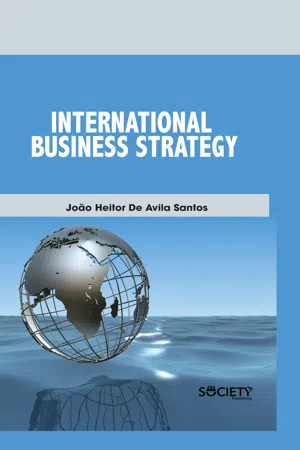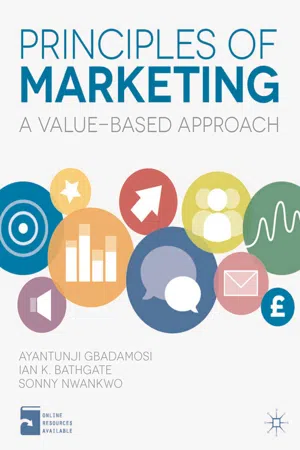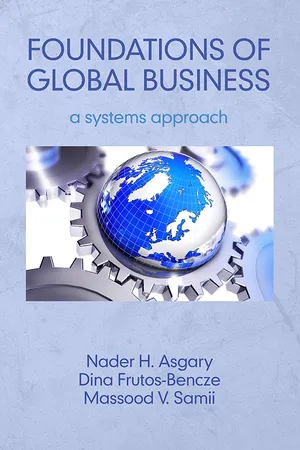Marketing
International trade system
The international trade system refers to the network of organizations, agreements, and regulations that govern the exchange of goods and services between countries. It encompasses trade policies, tariffs, quotas, and trade agreements such as the World Trade Organization (WTO) and regional trade blocs. The system plays a crucial role in shaping global commerce and impacting marketing strategies.
Written by Perlego with AI-assistance
Related key terms
1 of 5
3 Key excerpts on "International trade system"
- eBook - PDF
- Joao Heitor De Avila Santos(Author)
- 2019(Publication Date)
- Society Publishing(Publisher)
It is merely after careful study of these International Business Strategy 140 “globes” a truly global strategy can be designed and effectively implemented. Unity in variety is indeed the key principle of standard systems theory. The world can be regarded as a wide-open system made up of many subsystems, each which has its images, dreams, inspirations, goals, and goals to perform (Kanishchenko, 2004). A global online marketing strategy incorporates the normal attributes of lots of the subsystems. Trying to sell a product internationally Simply because it includes successfully satisfied the house country’s needs is not globalism; somewhat, it is ethnocentrism—the self-centered and mistaken assumption that what’s best for one’s own region or people, the “ethnos,” is wonderful for all of that other world. 9.2 THE FUNDAMENTALS OF MARKETING Although marketing function of a business is actually the same if the market is local or international, there are numerous adaptations that must definitely be carried out when certain key ideas and/or techniques are taken overseas. The North American Marketing Relationship, cognizant of the changes that contain occurred in the idea of marketing, has approved a fresh broader classification of marketing. Marketing is thought as the procedure of planning and performing the conception, charges, promotion, and circulation of ideas, goods, and services to setup exchanges that gratify person and organizational aims. Two concepts stick out in this description. First, you can find the theory that the look and execution connect not and then products but also to ideas and services. The brand-new definition stresses that marketing entails much more than simply retailing goods. Second, there exists the idea that the present day marketing function is definitely a strategic subject for the reason that it plays a part in the overall tactical mission of the business. - eBook - PDF
Principles of Marketing
A Value-Based Approach
- Ayantunji Gbadamosi, Ian Bathgate, Sonny Nwankwo(Authors)
- 2013(Publication Date)
- Bloomsbury Academic(Publisher)
A poor state of technology adversely affects international marketing operations ● International political-legal environment: – Political risk assessment: Political conditions are an important consideration. It does not make sense to invest in politically unstable places where violence may put the firm and its resources in jeopardy – Labour conditions: Labour conditions are internationally different (see Example 12.1) and need to be monitored – Legal instruments: Tax laws, import/export requirements and other regulations may affect international marketing – Rule of law: It is important to assess the credibility of the judiciary in order to assess whether the rule of law effectively applies in a specific market environ-ment. This has implications regarding legal protection of investments, lives and properties INTERNATIONAL MARKETING STRATEGY International marketers are frequently faced with a range of decisions that they have to make to be able to compete effectively. Making a decision to ‘go international’ and the mode of entry are only a part of the decision. They will also have to decide which products to market internationally and how to price, distribute, promote and segment the market in ways that help to deliver value to the consumer and, in return, achieve competitive advantage. International marketing strategy is simply about putting all the building blocks together – making both short-term and long-term decisions that lead a firm to achieve its international marketing goals. By and large, these decisions revolve around the controllable elements of the marketing environment, largely the marketing mix. - eBook - PDF
- Nader H. Asgary, Dina Frutos‐Bencze, Massood V. Samii(Authors)
- 2016(Publication Date)
- Information Age Publishing(Publisher)
The Global System 33 3% of the votes. Generally, landslide elections have become less frequent in many developed countries. One important factor of such electoral results is the phenomenon of national convergence/divergence. Foundations of Global Business, pages 35–50 Copyright © 2016 by Information Age Publishing All rights of reproduction in any form reserved. 35 3 The International trade system I n this chapter, the general structure of the international trading system is described. The concept of free trade and its implications are discussed as well. The main theories of international trade are presented, as they are what provide scientific arguments for the free trade system. Finally, the con- cept of dynamic shifts in competitive advantage is introduced. The Global Trade System Trade between countries is one of the oldest business activities. International trade theorists have developed several frameworks for policy analysis and evaluation of the impact of trade on the participants. International trade also impacts a country’s economic growth, employment, and inflations rates. In general, importing countries obtain products at lower costs than the equivalent ones produced domestically, and exporting countries tend to benefit from the job creation and revenues generated from the growth of their exporting industries. In addition, multinational enterprises (MNEs) usually benefit from the profit margin generated by export-import activities. 36 Foundations of Global Business Therefore, trade seems to benefit the countries as well as the multinational companies involved. Table 3.1 shows the world’s exports and the change in the export share in billions of USD from each region in the past 20 years. It can be seen that world trade has expanded considerably, particularly in the last two decades. Between 1983 and 2013 world trades have been significant, which is due to the globalization of economies.
Index pages curate the most relevant extracts from our library of academic textbooks. They’ve been created using an in-house natural language model (NLM), each adding context and meaning to key research topics.


